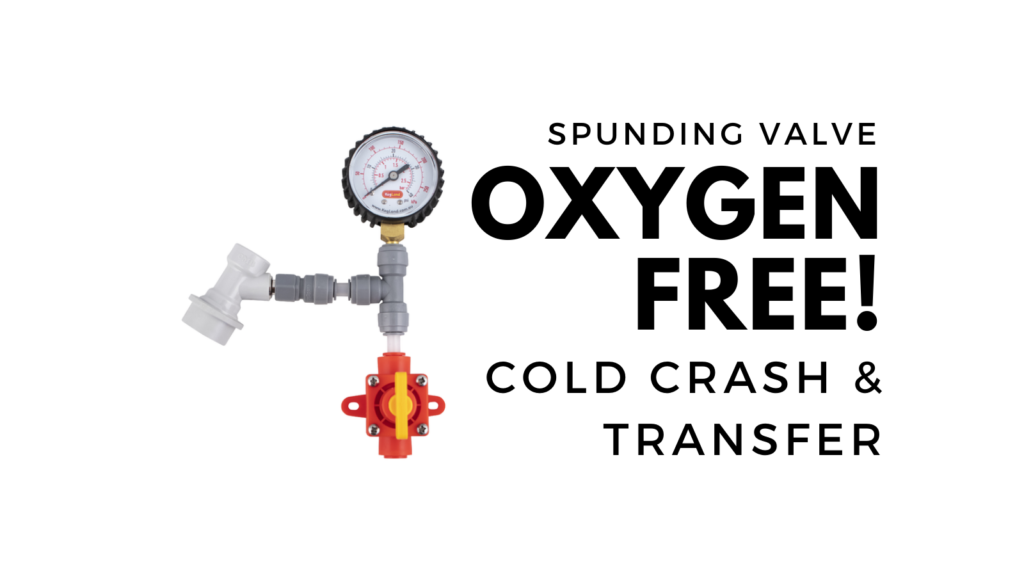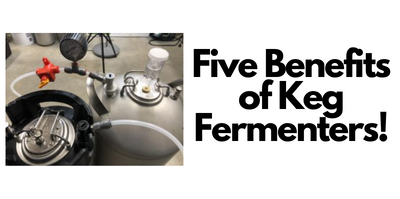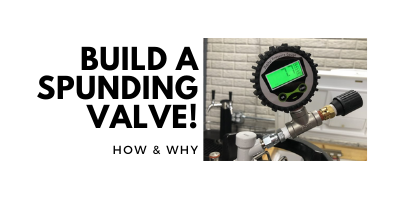
Oxygen Free Transfer and Cold Crash Using a Spunding Valve!
Updated: January 10, 2025
What is Cold Crashing?
Cold Crashing is chilling your beer after fermentation is complete. Typically you want to get as close to freezing as possible, without actually freezing your beer. These cooler temperatures cause break, yeast and trub matter to drop out of your beer. This increases clarity, helps to hasten the conditioning process and helps you get a cleaner transfer to your serving vessel.
What is a Spunding Valve?
A Spunding Valve allows you to ferment under pressure, naturally and precisely carbonate in the keg, fix over-carbonated beers and more. See: Build a Spunding Valve for more info.
Related Gear and Resources, Article Continues Below:
- Hands on Review: Kegland BlowTie Spunding Valve
- Build a Spunding Valve! – How and Why
- 10 gallon or 15 gallon keg Ball Lock Kegs – Hands on Review
- 10 Gallon Ball Lock Kegs
- 12 Gallon Ball Lock Kegs
- Convert a Keg Into a Fermenter
- Cornelius Keg Lid for Secondary Fermenter Include Silicone Stopper and Air Lock
- Torpedo Buoy via MoreBeer – Hands on Review
- Hands on Review: DuoTight Fittings & EVABarrier Tubing
- Five Benefits of Using Corny Kegs As Fermenters
Kegland BlowTie v2
- BlowTie 2 Diaphragm Spunding Valve with Gauge FE962 via MoreBeer
- Duotight Blowtie Spunding Valve with Gauge via William’s Brewing
- Kegland BlowTie v1Duotight BlowTie 2 Diaphragm Spunding Valve w/Integrated Pressure Gauge (0-23 PSI) for Pressure Fermentation – KL15042 affiliate link, note that multiple variations of this product may be available, as such a different version may appear at this link
Kegland BlowTie v1
- BlowTie Diaphragm Spunding Valve FE960 – via MoreBeer
- BlowTie Diaphragm Spunding Valve Complete Kit FE961 – via MoreBeer
- BlowTie Diaphragm Ball Lock beer Spunding Valve Complete Kit for Home Brewing beer corny beer keg affiliate link, note that multiple variations of this product may be available, as such a different version may appear at this link
This article contains affiliate links. We may make a small percentage if you use our links to make a purchase. You won’t pay more and you’ll be supporting Homebrew Finds and more content like this. Thank you for your support!
Related – Benefits of Using Kegs for Fermentation
Oxygen Introduced During Cold Crash
After fermentation the head space of your fermenter is mostly CO2. Active fermentation should have filled that space with CO2. CO2 is heavier than air so it stands to reason, that, for the most part, your beer is oxygen free after primary fermentation has ceased.
When you cold crash your beer is chilled, the liquid and gas inside your fermenter shrink. If your fermenter is not airtight and able to hold a vacuum, this causes atmospheric air including oxygen to be pulled in. As you transfer more air is pulled into the fermenter. Oxygen pickup is likely to occur. That’s not good. More oxygen = more oxidation.
Oxygen Free Cold Crash and Transfers Using a Spunding Valve
This process assumes that you have fermented in a keg – small (less than 5 gallon) batches in a 5 gallon keg or a full 5 gallon+ batch in a 10 gallon or 15 gallon keg.
Cold Crash
- If you’ve used a Spunding Valve for a fermentation airlock, remove that. Or, if you’ve used a fermentation lid, blowoff tubing or other such solution, carefully replace with standard lid, posts, poppets, etc to make the keg pressure capable again.
- Optional: Pressurize the head space of the keg to a lower pressure (5 PSI or so) that’s compatible with your equipment and purge the head space of your fermentation keg. Fill head space and bleed off pressure a couple times.
- Pressurize the fermentation keg to serving pressure. Serving pressure isn’t exactly required. Just a moderate pressure that’s compatible with your equipment and is high enough to maintain a seal after the pressure drop you’ll experience during cold crash. Serving pressure, 10 or so PSI for most, should do the trick.
- Cold crash the fermentation keg.
- Assuming the keg is leak free your fermentation keg should remain at pressure as the keg chills to just above freezing. This means no oxygen intake during the cold crash.
- Note that pressure is likely to drop because of the temperature change. The key is to have enough pressure to maintain a seal on the keg lid. You can also experience a drop because CO2 will be dissolved into your beer (it’s starting to carbonate). If you cold crash for an extended period of time you may need to re-pressurize to maintain a seal on your keg lid.
Transfer
- Purge the cleaned and sanitized serving keg with CO2. This will be the receiving keg that you’ll be transferring beer to.
- Charge both fermentation keg and serving keg to the same pressure. I suggest something in the lower range, like 5 PSI. Again, make sure your chosen pressure is compatible with your equipment.
- After equalizing both kegs put your gas line on the gas-in post of the fermentation keg. You want to use this pressure to push beer from the fermentation keg to serving keg. Your fermentation keg liquid out post should be empty at this point.
- Use a sanitized liquid to liquid jumper (a piece of tubing with QDs on each end) to connect the fermentation and serving kegs liquid posts. This allows the serving keg to fill from the bottom up.
- Set your Spunding Valve to completely closed
- Put your Spunding Valve on the gas post of the serving/receiving keg
- Slowly adjust the Spunding Valve to allow a slow flow of beer from your fermentation keg to your serving keg.
Minimizing Trub Pickup
There will be trub in the fermentation keg. You can either trim the liquid dip tube to minimize this problem or use something like a Torpedo Buoy. More about the Torpedo Buoy solution can be found in my 10 gallon Torpedo Keg Review.
Gear and Resources, Article Continues Below:
- Hands on Review: Kegland BlowTie Spunding Valve
- Build a Spunding Valve! – How and Why
- 10 gallon or 15 gallon keg Ball Lock Kegs – Hands on Review
- 10 Gallon Ball Lock Kegs
- 12 Gallon Ball Lock Kegs
- Convert a Keg Into a Fermenter
- Cornelius Keg Lid for Secondary Fermenter Include Silicone Stopper and Air Lock
- Torpedo Buoy via MoreBeer – Hands on Review
- Hands on Review: DuoTight Fittings & EVABarrier Tubing
- Five Benefits of Using Corny Kegs As Fermenters
Kegland BlowTie v2
- BlowTie 2 Diaphragm Spunding Valve with Gauge FE962 via MoreBeer
- Duotight Blowtie Spunding Valve with Gauge via William’s Brewing
- Kegland BlowTie v1Duotight BlowTie 2 Diaphragm Spunding Valve w/Integrated Pressure Gauge (0-23 PSI) for Pressure Fermentation – KL15042 affiliate link, note that multiple variations of this product may be available, as such a different version may appear at this link
Kegland BlowTie v1
- BlowTie Diaphragm Spunding Valve FE960 – via MoreBeer
- BlowTie Diaphragm Spunding Valve Complete Kit FE961 – via MoreBeer
- BlowTie Diaphragm Ball Lock beer Spunding Valve Complete Kit for Home Brewing beer corny beer keg affiliate link, note that multiple variations of this product may be available, as such a different version may appear at this link
More Homebrew Finds!
- Last 50 Finds!
- Top Deals – a curated list of the best deals
- Homebrew Reviews – one of the largest libraries of homebrew reviews in existence!
- Our Top Posts – tips, how-tos, resources posts and more
- Let’s be Friends!
Recent Deals!
10 Most Recent Homebrew Resource Posts & How-To’s!
We are Homebrew Review HQ! Our 10 Most Recent Reviews
More Fermentation Related!
pinned
This post may contain affiliate links. We may make a commission when you use our links. This will never cost you extra. Thank you for supporting Homebrew Finds!
greatdealsMake sure the components you use are compatible and rated for your intended application. Contact manufacturer with questions about suitability or a specific application. Always read and follow manufacturer directions. tag:lnksfxd -toppost:oxyfree rs:8 tag:tpr

















